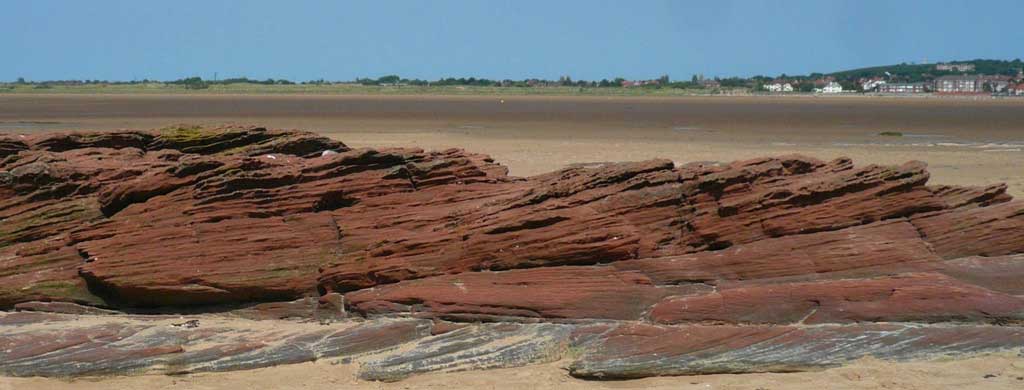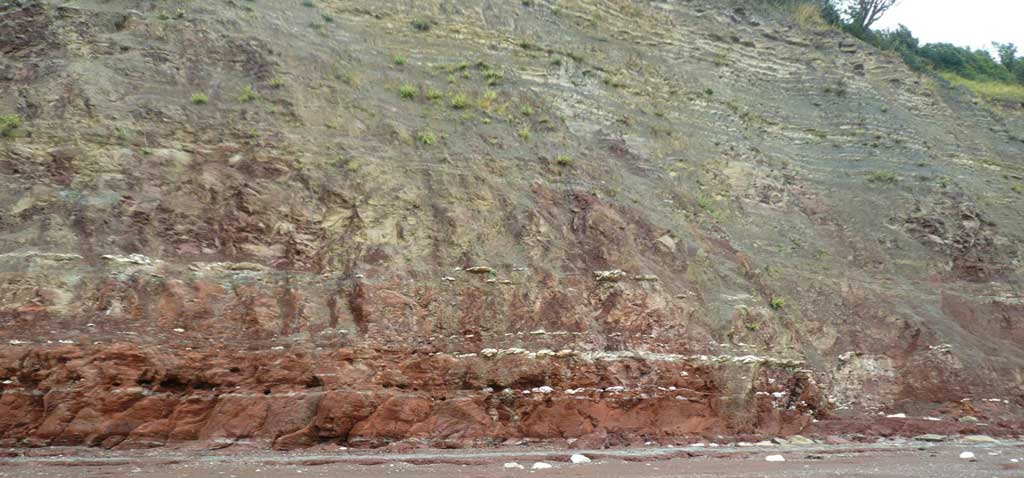August: The Triassic Period
During the Triassic period (245-199 million years ago) Wales continued to be subjected to arid or semi-arid conditions in a low-latitude desert type environment, and most of north-western Europe was still undergoing mainly east-west oriented extension, associated with the early stages of North Atlantic rifting. This led to the deposition of localised fluvial channel sands and pebbles in the Cheshire Basin, inter-bedded with larger areas of wind-blown desert sands. Ephemeral playa lakes formed locally in the deeper parts of active, fault controlled basins, and occurred more extensively in the larger, more rapidly subsiding East Irish Sea Basin to the north. These areas accumulated thick lacustrine muds and salt deposits. Some of these desert sand dune and fluvio-lacustrine deposits are now beautifully exposed in the low cliffs and rock outcrops of Hilbre Island, just off the coast of North Wales, in the mouth of the Dee Estuary (see Photos 31 and 32).

Photo 31. Cross-bedded Lower Triassic Sherwood Sandstone Group sandstones exposed in the eastern end of Hilbre Island in the Dee Estuary, just off the North Wales coast. These sands were deposited in an arid desert environment with large areas of sand dunes interspersed with localised fluvial channel networks and ephemeral lakes.

Photo 32. Low to high angle cross-bedded sandstones of the Sherwood Sandstone Group exposed in the southern face of Hilbre Island in the Dee Estuary, just off the coast of North Wales. The flatter lying, pale cream coloured layers may represent interbeds of ephemeral lacustrine clays.
In South Wales, similar, red, cream or greenish coloured Triassic age sediments are also well displayed in the cliffs of Ranny Bay and Lavernock Point, on the Glamorgan coast, just south of Penarth and Cardiff (Photo 33). The lower section of the sediments shown here were probably deposited in terrestrial or coastal ‘saline desert lake environments’ as they are bright red due to iron oxide staining, and locally contain layers of white gypsum nodules which probably represent ‘evaporite deposits’. The upper cliff section is more cream or greyish in colour, and probably reflects a gradual change from semi- desert, or coastal ‘sabkha/playa lake’ deposits in the Early Triassic Period, to more ‘restricted marine’ and eventually more ‘open marine’ deposits in the Late Triassic to Early Jurassic Periods.

Photo 33. Silty mudstones and marls of the Late Triassic Mercia Mudstone Group exposed in the cliffs of Ranny Bay, near Penarth, South Wales. The red colouration in the lower cliff section indicates deposition in a semi-arid or arid saline or ephemeral lake environment. The distinctive white gypsum nodules in the lower cliff section suggest periods of more extensive evaporation, leading to the deposition of evaporitic gypsum salts. The creamy grey to greenish grey rocks in the upper cliff indicate a change to restricted marine and open marine environments, produced in the Late Triassic to Early Jurassic rise in global sea levels, which resulted in widespread marine transgression.
These changes were probably due to a gradual ‘marine transgression’ onto the Welsh landmass in the Late Triassic to Jurassic Periods, as global climates became warmer and sea levels rose. The effects of this marine transgression can also be seen in North Wales and Northern England.

